Dec . 21, 2024 20:16 Back to list
suspended ceiling cross tee
Understanding Suspended Ceiling Cross Tees An Essential Component in Modern Interior Design
Suspended ceilings, also known as drop ceilings or false ceilings, have gained substantial popularity in modern interior designs, both in residential and commercial spaces. Central to the construction of these ceilings are the cross tees, which play a pivotal role in shaping the overall aesthetics and functionality of such installations. This article explores the definition, importance, types, and installation processes associated with suspended ceiling cross tees.
What are Suspended Ceiling Cross Tees?
Suspended ceiling cross tees are horizontal metal or aluminum supports that connect the vertical main runners within a suspended ceiling grid system. This grid forms the framework on which ceiling tiles or panels are laid, allowing for the creation of smooth, continuous ceilings that can hide ductwork, wiring, and other installations above the ceiling plane. Cross tees are essential for dividing the grid into smaller sections, enabling the installation of various ceiling panel sizes and styles.
Importance of Cross Tees in Suspended Ceilings
The use of cross tees in suspended ceilings serves several critical purposes
1. Structural Support Cross tees provide necessary support for the ceiling tiles and help maintain the integrity of the ceiling system. Without them, the weight of the tiles could lead to sagging or structural failure.
2. Aesthetic Appeal They contribute to the overall aesthetic of a space by allowing for different panel designs and arrangements. With the correct installation of cross tees, designers can create various ceiling patterns, enhancing the visual interest of the environment.
3. Flexibility in Design Cross tees allow for the easy modification and replacement of ceiling tiles. If a panel gets damaged or stained, it can be swiftly replaced without affecting the entire ceiling structure.
4. Accessibility Suspended ceilings can offer access to plumbing, wiring, and HVAC systems above the ceiling. The grid created by cross tees facilitates easy removal and replacement of tiles for maintenance and inspection.
Types of Suspended Ceiling Cross Tees
There are several types of cross tees available, each designed for different applications and configurations
1. Standard Cross Tees These are typically 2 feet long and are used to create a basic grid structure, suitable for most residential and commercial applications.
suspended ceiling cross tee

3. Slotted Cross Tees These feature slots that allow for the easy installation of lighting and other ceiling fixtures, supporting the integration of various systems.
4. Heavy-duty Cross Tees Designed for higher load-bearing applications, these are used in environments where the ceiling needs to support extra weight, such as in industrial settings.
Installation Process of Suspended Ceiling Cross Tees
Installing suspended ceiling cross tees is a structured process that requires attention to detail. Here’s a step-by-step guide to ensure a successful installation
1. Planning and Measurement Begin by measuring the space where the ceiling will be installed. It’s vital to ensure that all dimensions are accurate for a seamless fit.
2. Marking Lines Use a chalk line to mark where the main runners will be placed. Typically, these are spaced 4 feet apart.
3. Installing Main Runners Attach the main runners to the ceiling using appropriate hangers and fasteners, ensuring they are level and securely mounted.
4. Adding Cross Tees Insert the cross tees into the main runners at measured intervals, usually every 2 feet. Make sure they are also level and securely fit into the main runners.
5. Laying Ceiling Tiles Once the grid is complete, lay the ceiling tiles or panels on top of the cross tees, ensuring they are properly aligned and fit snugly.
6. Final Check After installation, conduct a final check to ensure that all panels are secure and that the ceiling is level.
Conclusion
Suspended ceiling cross tees are a crucial component of any suspended ceiling system, offering structural integrity, aesthetic versatility, and ease of installation and maintenance. Understanding their role and the various types available can help designers and builders create functional and visually appealing spaces. As the demand for organized and aesthetically pleasing interiors grows, awareness and knowledge of components like cross tees will become increasingly important. Whether in a commercial office, retail environment, or residential home, suspended ceilings with well-installed cross tees remain a trusted solution for modern design challenges.
-
Quality Ceiling Trap Doors & Access Panels | Easy & Secure AccessNewsAug.30,2025
-
Durable Ceiling T Grid Systems | Easy InstallationNewsAug.29,2025
-
PVC Gypsum Ceiling: Durable, Laminated Tiles for Modern SpacesNewsAug.28,2025
-
Pvc Gypsum Ceiling Is DurableNewsAug.21,2025
-
Mineral Fiber Board Is DurableNewsAug.21,2025
-
Ceiling Tile Clip Reusable DesignNewsAug.21,2025







